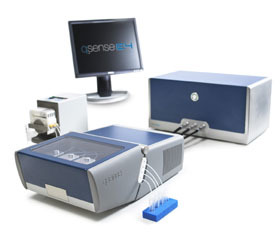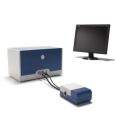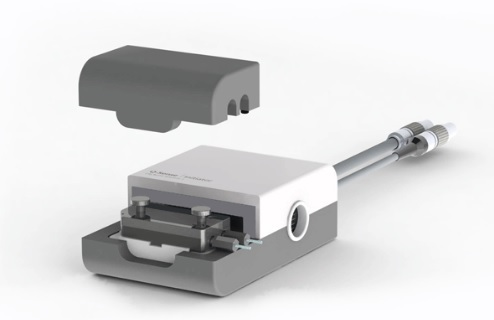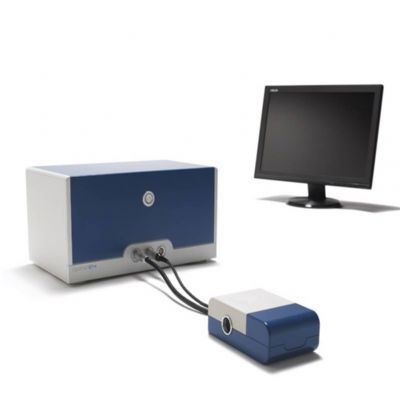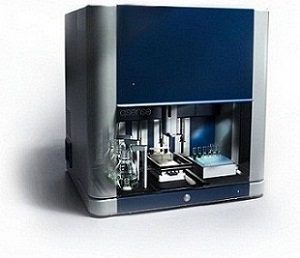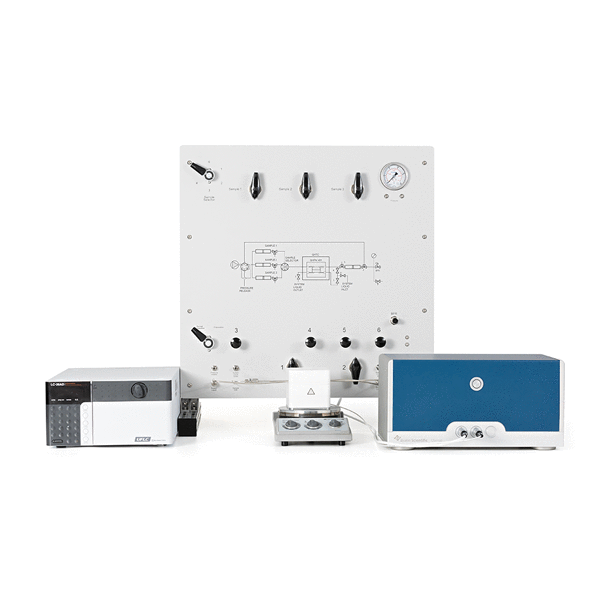方案详情
文
抗体和不同种类的抗原的相互作用吸引了医疗方面和研究机构的广泛兴趣。使用筛查工具来检测他们的相互作用变得非常有意义。本文中使用了QCM-D结合自动进样器进行了稳定重复的抗体抗原相互作用反应。
方案详情

Biolin Scientific[ Progress Together] [Application Note] 21 Probing repeated antibody-antigen interactions by theuse of Q-Sense biotin functionalized sensors Antibodies and their interactions with different antigens are subjects to greatinterest both for the pharmaceutical industry and a wide variety of research areas.Screening tools targeting these interactions are therefore of great value and here QCM-D integrated with an autosampler was used to enable multiple, stable cycles of antibody-antigen interactions. Quartz Crystal Microbalance with Dissipation monitoring (QCM-D)is an acoustic, surface sensitive technique that measures changesin mass and viscoelastic properties in real-time at a surface. Thecoupled mass at the sensor surface is related to the resonancefrequency change of the crystal oscillation, Af, and includes bothactual biomolecular mass and liquid medium associated with it.The energy dissipation change of the crystal oscillation, AD, isrelated to the viscoelastic properties of the material adsorbed tothe sensor. Experimental Q-Sense biotin functionalized sensors were used to specificallyimmobilize streptavidin (SA, conc. 25 ug/ml) while minimizingnon-specific protein binding and enabling subsequentimmobilization of biotinylated protein-A (25 g/ml). Protein-Abinds to the heavy chain Fc region of immunoglobulin (Ig)antibodies and this enabled the assay illustrated in fig. 1 to becreated with bovine serum albumin (BSA) and IgG anti-BSA (IgG-BSA). Phosphate buffered saline (PBS) was used as running anddiluting buffer. lgG anti-BSA Streptavidin Gold sensor [Figure 1]: SA immobilized to a Q-Sense biotin functionalized sensor (biotin,se above) and subsequently bound biotin-Protein A, IgG anti-BSA (IgG-BSA)and BSA. The antibody-antigen (Ab-Ag) complex of IgG-BSA and BSA is laterremoved by NaOH regeneration in fig. 2 The interaction between IgG-BSA (50 ug/ml) and BSA (100 ug/ml)was regenerated by subjecting the surface to NaOH (10 mM) thatis known to dissolve this interaction while keeping the protein-Aintact. Results and discussion The assay described (fig. 1) was performed using the Q-Sense E4Auto with excellent immobilization and regeneration results (fig.2). Handling time was reduced to less than 1 h by using the E4Auto setup, while the measurements were performed overnightfor more than 10 h. Regeneration of the immobilization of IgG-BSA and BSA with NaOH did not effect the stability of the SAor protein-A and five regeneration/immobilization cycles couldbe done in sequence with reproducible amounts of immobilizedprotein (see fig. 2 and 3). During regeneration, the IgG-BSAand BSA were released likely due to the drastic change in ionicenvironment at NaOH exposure, which disturbs the chargedependent interactions between protein-A, IgG-BSA and BSA. [Figure 2]: Complete measuring sequence for the 7th overtone (a), the dashedbox is magnified (b) and shows the Ab-Ag regeneration sequence that wasrepeated 5 times using the Q-Sense E4 Auto system. One interesting aspect is that the IgG-BSA was immobilizedfrom a diluted polyclonal antibody serum solution containing awide variety of proteins. Despite this complex test solution themeasurement setup enabled the IgG-BSA and BSA interactionwhich indicate low non-specific protein binding and that theimmobilized protein-A still was active. Adsorbed mass was modeled using viscoelastic modeling inQTools* with results shown in fig. 3. SA, protein-A and BSA havesimilar molecular weights of 53, 50 and 66 kDa respectively andis also reflected in the adsorbed mass. The used IgG-BSA hasunspecified molecular weight but is typically> 150 kDa and this isalso indicated by the higher mass adsorption of the antibody. Conclusion Q-Sense biotin functionalized sensors proves to enable specificimmobilization of streptavidin and subsequent biotinylatedbiomolecules while minimizing non-specific adsorption. Thisimmobilization strategy can be used to study biomolecularinteractions, here shown successfully for protein-A, IgG-BSA andBSA. The Q-Sense E4 Auto setup enabled repeated antibody-antigen interactions to be screened for over 10 h with excellentreproducibility. Automatic sample handling greatly reduced therequired handling time. This methodology could be used indrug discovery as a screening tool, potentially presenting newviscoelastic information not easily obtainable from other methods. Protein immobilization [Figure 3]: Adsorption levels for SA, protein-A, IgG-BSA and BSA* QTools is a viscoelastic modeling and curve fitting software provided byQ-Sense. References: This study was performed by Biolin Scientific AB. Biolin Scientific [Progress Together] E-mail:info@biolinscientific.combiolinscientific.com [ ]Q-Sense AN
确定
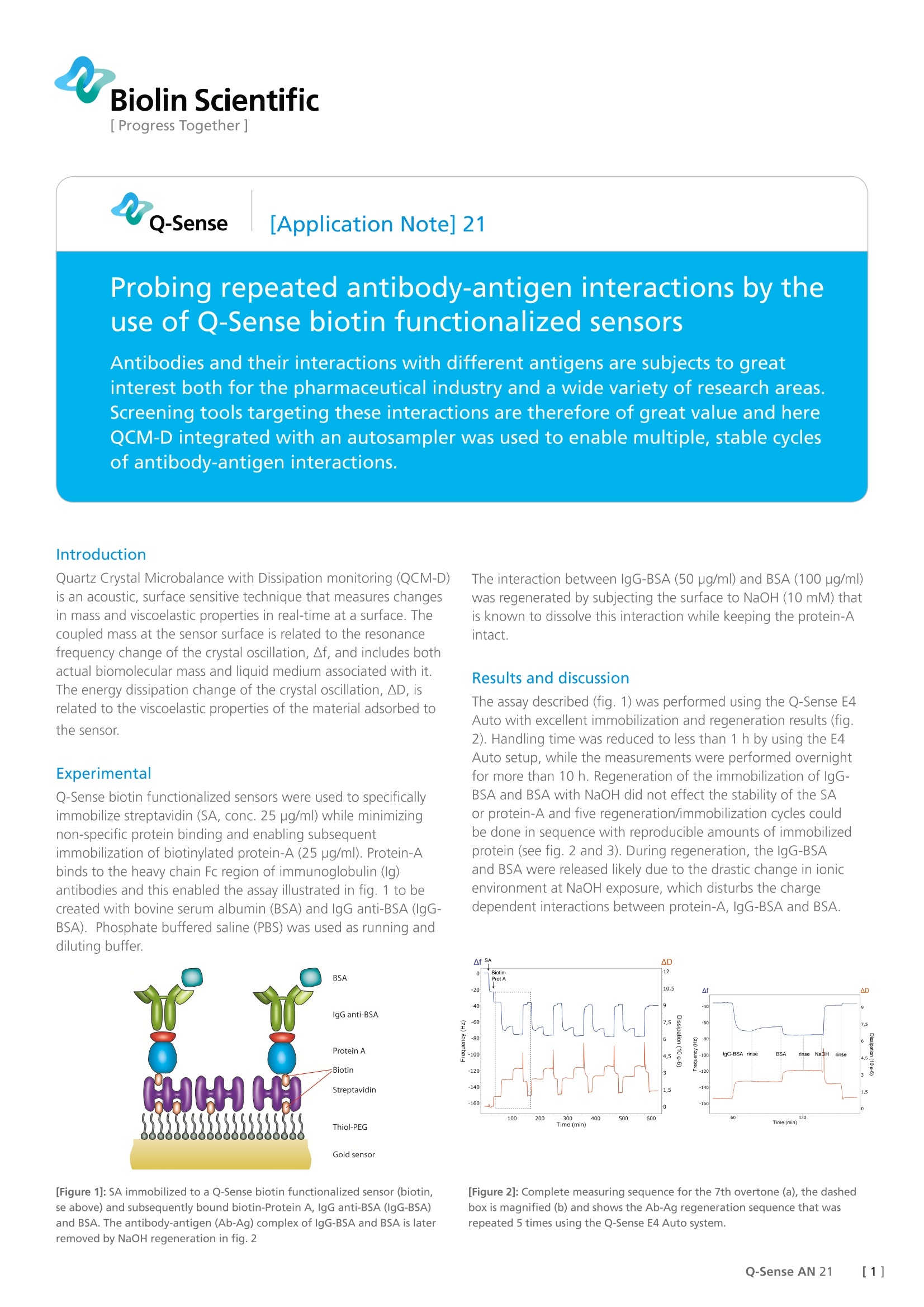

还剩1页未读,是否继续阅读?
瑞典百欧林科技有限公司为您提供《使用Qsense功能化生物素芯片检测抗体-抗原重复相互作用》,该方案主要用于其他中--检测,参考标准--,《使用Qsense功能化生物素芯片检测抗体-抗原重复相互作用》用到的仪器有QSense卓越版四通道石英晶体微天平、QSense Explorer扩展版石英晶体微天平、QSense全自动八通道石英晶体微天平
推荐专场
相关方案
更多
该厂商其他方案
更多

